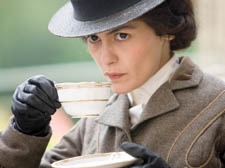|
|
 |
| |

Audrey Tautou as Coco Chanel |
Corsets and contradictions of Coco Chanel
COCO BEFORE CHANEL
Directed by Anne Fontaine
Certificate 12a
COCO Chanel has become a by-word for style, and this study of the French designer’s early years has plenty to spare.
We meet the young Coco as she is being dumped at an orphanage aged nine. The austere starched outfits of the nuns in charge and the razor sharp creases on the children’s pinafores are all too apparent and it tells us Chanel was a sponge, soaking up influences everywhere, and that 20 years later she’d be drawing on this orphanage chic.
Then things fast forward 10 years, and we meet Coco again, this time working as a seamstress by day and a cabaret singer with her sister Adrienne (Marie Gillain) at night. One day she meets loaded playboy étienne (Benoît Poelvoorde) and before you know it she takes up residence at his country retreat as his mistress, though before long she is offering style tips to his rich friends. Meanwhile, she meets English gent Boy (Alessandro Nivola) and so begins a love affair that will shape the rest of her life.
While romancing her love, her development as a designer takes hold. She graduates from making her own clothes into working for well-off Parisians.
We are also shown how she created her trademark looks: while she wanders across a beach with Boy, we watch fishermen bring in a catch. They are wearing smocks and underneath the stripy white and blue of a Breton fisherman.
Even for someone like me who has no interest in fashion nor knowledge of Chanel, this is an iconic look that you’ll recognise.
Chanel’s secret was something that other designers were doing at the same time: the rise of Bauhaus architecture did away with frivolous adornments on housing. Pitched roofs which hung over the walls of buildings smacked of Victorian grandness, like the crowns on top of the monarchs’ heads. This was dead: this was so-o-o 19th century, and as the Bauhaus group were ridding their drawing boards of such adornments. Coco did the same: she hated frilly ballgowns and hats with feathers.
This is a film about corsets and contradictions. One of her big things was to do away with the restrictive corset, and it becomes a metaphor for women’s liberation. But here in lies a contradiction. Chanel is now one of the world’s fashion power houses, and therefore must take a degree of responsibility for what the author Naomi Wolf called The Beauty Myth. Wolf argued that the “male-industrial” complex, ie big business and male-run institutions, use the concept of female beauty as a means to sell stuff to us, without worrying about how concepts of beauty impact on women’s lives and is an under-hand form of oppression. So on the one hand, while Chanel’s approach may have been considered emancipating for my grandmother’s generation, its influence into the 21st century, it could be argued, promotes male chauvinism. |
 |
|
 |
| |
|
 |
|

